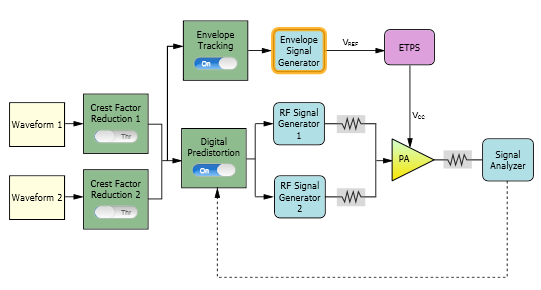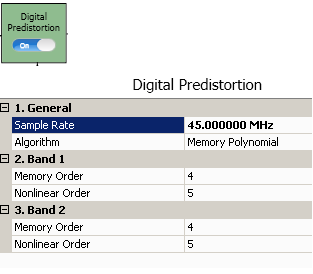
The following figure shows the block view settings in N7614B for a dual-band ET measurement.

The remaining section of this topic provides an example procedure of setting N7614B for DPD measurement. Note that for different PA, the settings are different. But there is normally total 10 typical steps to set all related parameter before executing measurement.
Step 1: Set the Waveform Blocks
Step 2: Set the Crest Factor Reduction Blocks
Step 3: Set the Digital Predistortion Block
Step 4: Set the RF Signal Generator Blocks
Step 6: Set the Signal Analyzer Block
Step 7: Set the Measurement View
Step 8: Set the Envelope Signal Generator Block
Step 10: Set the Envelope Tracking Block
Click on the Waveform 1 block icon on the UI. In the  right panel, select Preloaded as the Waveform type and select the "LTE_FDD_5M_QPSK_FullRB.wfm" file, set the Bandwidth to 5 MHz according to the waveform bandwidth.
right panel, select Preloaded as the Waveform type and select the "LTE_FDD_5M_QPSK_FullRB.wfm" file, set the Bandwidth to 5 MHz according to the waveform bandwidth.
Click on the Waveform 2 block icon on the UI. In the  right panel, select Preloaded as the Waveform Type and select the "LTE_FDD_5M_QPSK_PartialRB.wfm" file, set the Bandwidth to 5 MHz according to the waveform bandwidth.
right panel, select Preloaded as the Waveform Type and select the "LTE_FDD_5M_QPSK_PartialRB.wfm" file, set the Bandwidth to 5 MHz according to the waveform bandwidth.
If you want to use a waveform generated by another Keysight signal studio, set Waveform Type to Signal Studio and select the file. Refer to Creating and Exporting Waveforms for details about exporting a waveform file.
Note that to use a waveform generated by other signal studio software for DPD test, the instrument needs to have the corresponding license. For this example, to use LTE waveform, the N7624B license needs to be installed in the instrument
To perform dual-band DPD measurement, the two waveforms selected for the two bands should have equal time duration; otherwise, DPD measurement will abort.
In both Crest Factor Reduction blocks, set the switch to Thr (through).

In the Digital Predistortion block set the switch to On.

In the  right panel, do the following:
right panel, do the following:
Set the Sample Rate to 45 MHz, which makes the oversampling ratio of both the waveforms to be 4. Both of the waveforms will be resampled to the sampling rate specified here. To extract the DPD model, it is expected that the oversampling ratio of both waveforms is no less than 3.
Set the Memory Order of Band 1 to 3, and set the Nonlinear Order of Band 1 to 4.
Set the Memory Order of Band 2 to 3, and set the Nonlinear Order of Band 2 to 4.
Different power amplifiers may have different characteristics, which will need different DPD models to simulate the DPD performance. In DPD test, if the measurement results are not as expected, you can try to change the parameters for DPD model extraction.
Click the RF Signal Generator block. In the right panel, do the following:
Enter the IP address or host name of the RF Signal Generator and the toggle the connect button on the top of the window to Connected state. After the instrument is connected, the model number and serial number of the instrument will be displayed in the Instrument cell.
Set Frequency to 2.5 GHz on RF Signal Generator 1, and set Frequency to 2.1 GHz on RF Signal Generator 2.
Click the PA block. In the right panel, do the following:
Enter the PA information by setting the Loss Out, Loss In, and PA Gain for both bands.
Set Input Power to -1 dBm for Band1 and -2 dBm for Band2.
The initial Amplitude setting in the RF Signal Generator block will be set to (Input Power + Loss In) automatically.
Click the Signal Analyzer block. In the right panel, do the following:
Enter the IP address or host name of the Signal Analyzer and the toggle the connect button on the top of the window to Connected state. After the instrument is connected, the model number and serial number of the instrument will be displayed in the Instrument cell.
Set the Capture Sample Length to 61440 samples. For most cases, you can use the default values in this model.
Click the  button to change the current view from
button to change the current view from  block view to
block view to  measurement view.
measurement view.
Click the Envelope Signal Generator block. In the  right panel, do the following:
right panel, do the following:
Select the type of Envelope Signal Generator in the Configuration setting. In this example, select Arbitrary Waveform Generator.
Enter the IP address or host name of the Envelope Signal Generator and the toggle the connect button on the top of the window to Connected state. After the instrument is connected, the model number and serial number of the instrument will be displayed in the Instrument cell.

For other values, you can use the default settings. Note that the Voltage and Voltage Offset value will be set automatically after the test flow is run.
Refer to Voltage Mapping in Envelope Tracking Measurement for more details about Voltage Mapping.
Click the ETPS block. In the  right panel, do the following:
right panel, do the following:
Set the ETPS Gain to 7.0 dB.
Set the Vcc Offset to 2.75 V.
Set the Vcm to 450 mV.
Refer to Voltage Mapping in Envelope Tracking Measurement for more details about Voltage Mapping.
Switch the Envelope Tracking block to On. In the  right panel, do the following:
right panel, do the following:
![]()
Select the From Non-predistorted Signal as the envelope source.
Select 2D Supply Modulation Technique as the algorithm which is internal algorithm.
Set OSR for Envelope to 3.
Regarding the timing alignment related setting, user can set the course value which can be used to later alignment action.
In the Details part, user add their own  shaping table.
shaping table.